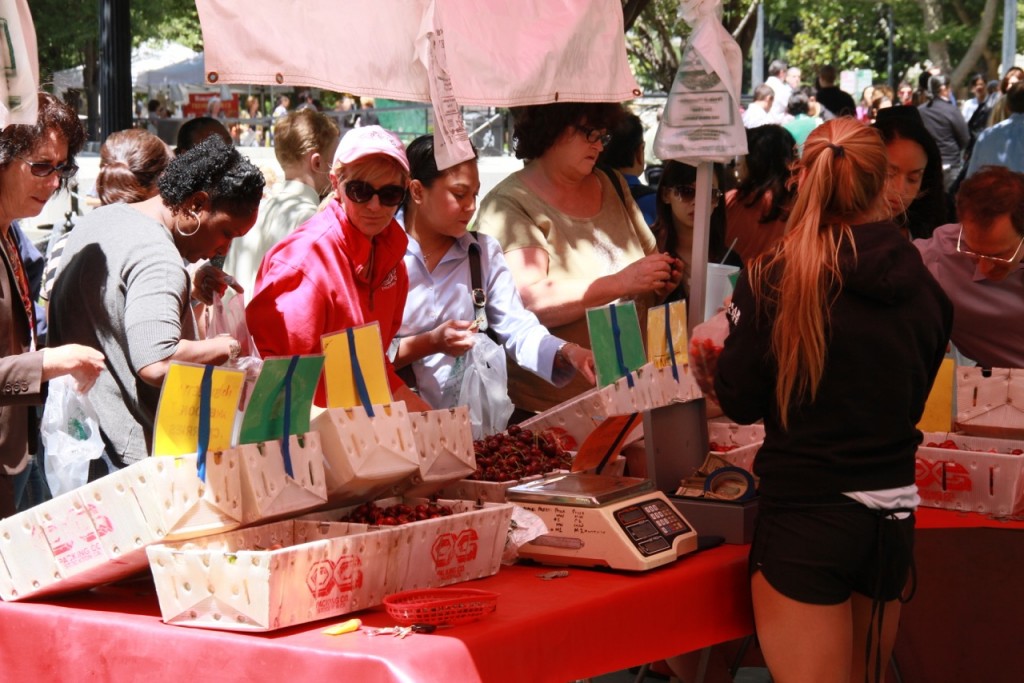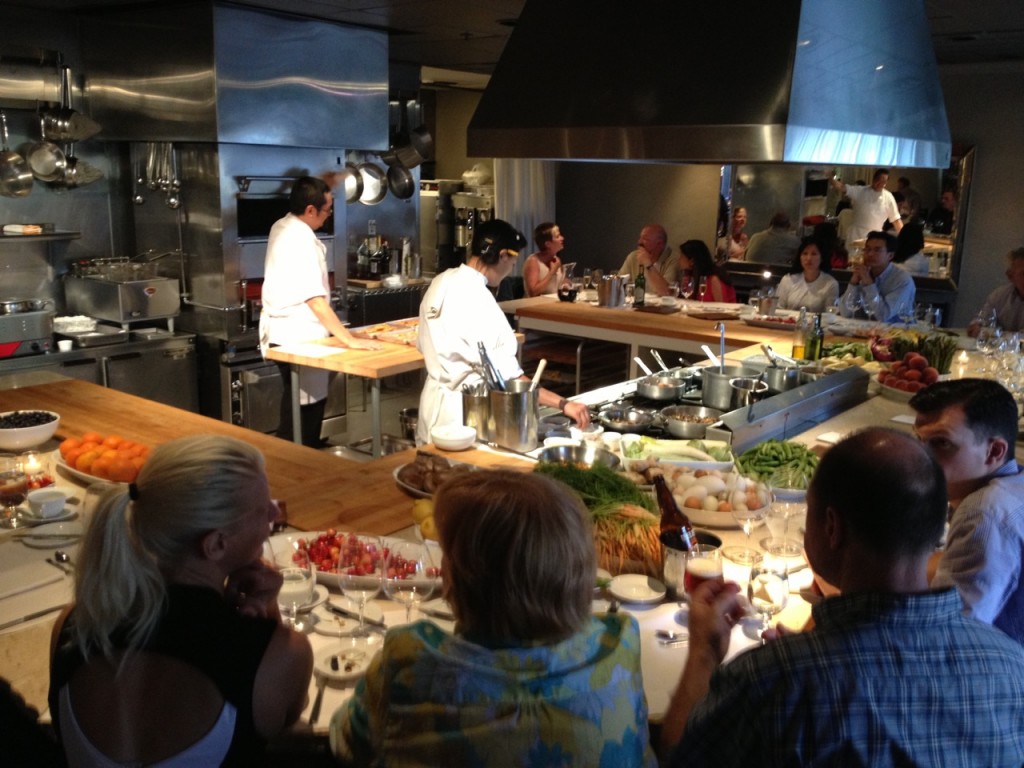Charlotte Biltekoff in a recent blog entry notes, “The foodworld is abuzz with the promise of transparency.” The premise is that new trends in food marketing better inform consumers about where and how their food is produced. And as Biltekoff considers, transparency creates further complexity. Certainly, “eating local” similarly supports the notion of transparency in the food system. My objective here is to examine how urban branding around “eating local” shapes the urban landscape. I focus on the city of Sacramento, California to illustrate the ways in which the city council and restaurateurs tacitly employ the notion of food transparency to upgrade the urban landscape to accrue capital.
In 2013, Mayor Kevin Johnson declared Sacramento “America’s Farm-to-Fork Capital.” The marketing campaign asserts that because Sacramento is situated within the largest agricultural producing hearth in the United States, the majority of Sacramento’s citizens eats locally sourced food by sheer dint of geography. In order to pronounce this relationship, city council and restaurateurs must find ways to inject the region’s agricultural aesthetic into the city’s image. For instance, the restaurant Roxy accomplishes this through the use of photographs from the local ranches where they source their meat. Customers view images of cows grazing gracefully as they nosh on their all-natural beef burgers. The country and the city are unified through semiotic markers that link food production processes with food consumption practices. Accordingly, farmers markets and restaurants become significant, socially symbolic spaces that reshape the urban landscape in order to promote the farm-to-fork narrative.

Cherry stand at the rotating market in Cesar E. Chavez Square Park on a Wednesday afternoon. (Photo credit, Robert D. Lemon).
Sacramento’s city council and restaurateurs are refashioning the urban landscape through the cultural capital of food. Their goal is to create a strong sense of place through the social interactions associated with eating and drinking. Part of their story, “farm-to-fork is all around us,” is making locally produced foods omnipresent. Here, “lifting the veil” means putting the consumer in direct contact with the farmer at farmers markets. But more importantly, city planners use these social exchanges to activate urban space. Underused streets, sidewalks, squares, and fallow spaces below freeways transform into visual and olfactory pleasures for the urban dweller with the appearance and aromas of food stalls.
Sacramento has rotating farmers markets throughout the week. Cesar Chavez Square Park, typically an underused square in a dilapidated downtown corridor, becomes a vibrant street market every Wednesday afternoon. The main farmers market under I-80 near South Side Park bursts at the seams each Saturday. There are another 10-plus farmers markets that rotate throughout the metropolis, transforming empty sidewalks and vacant parking lots into effervescent gastronomic oases. Accordingly, farmers markets become integral sites/sights to experientially link the bounty of the country to urban consumer culture. Certainly, farmers markets allow one to develop a more profound sense of place through food voyaging and embodying the physical fruits of Sacramento’s region.
Social interactions formed around food are integral to spatial transformation of the city—from exterior urban spaces to interior design. Not only are aspects of farmers markets a central component to urban life, but so too is the design of restaurant space. For sure, the kitchen is a significant spatial nexus between the country and the city. The kitchen is where raw foods are cleaned and cooked. Kitchen space is where food is transformed. It is no surprise that the kitchen space in restaurant design is increasingly becoming better incorporated into the dining experience. For instance, Randall Selland uses the kitchen space as the focal point of his restaurant, The Kitchen, to forge social interactions and foster the farm-to-fork philosophy. The kitchen’s central and open design spatially reorganizes the social activates that take place in the restaurant. Here the boundary between the production (cooking) and the consumption (eating) sides of urban dining is eliminated. The entire experience is a dining education about farm-to-table. Certainly, restaurant spaces across the nation are transforming to a more open floor plan to heighten the aspect of transparency in the food system. And this is especially true amongst Sacramento’s downtown dining establishments. Many restaurants have open floor plans that unfold from the kitchen onto the street. Open kitchens, long bars, outdoor patios, and sidewalk cafes are all designed to accommodate the changing culture of cosmopolitan culinary practices.

Patrons enjoying their time eating at the kitchen bar in Randall Selland’s James Beard Award winning restaurant, The Kitchen. (Photo credit, Robert D. Lemon).
The upgrading of the urban environment around food practices is associated with a process I refer to as gastro-gentrification.[i] Gastro-gentrification is the changing character and shifting demographic of the city and/or a neighborhood through food practices. It is the creation of innovative and/or ethnic restaurants, urban agriculture, farmers markets, food trucks, eating local, “slow food” or any other food movement that transforms the atmosphere of an urban environment and consequently the residential demographic. For sure, coffee shops, boutique bakeries, specialty grocery stores, and ethnic food stands are often catalysts for gentrification. In the past, one could perceive these spatial reconfigurations and demographic shifts. Today, however, cosmopolitan culinary practices are not only perceived but also conceived by city planners, city councils, and urban developers. Planned gentrification through food has become a new agent of urban renewal.
In most scenarios, gentrification and urban renewal are not without aspects of exclusion. In Sacramento, the consumption end of the food spectrum becomes a spectacle for middle and upper middle-class urban life that tends to reinforce romanticized views of Jeffersonian agrarianism. For sure, California was a land of large industrialized agriculture from its inception. Moreover, Mexican day laborers pick nearly all of the produce in California, not to mention they perform much of the work in the back kitchens. These aspects of labor in California’s food system are not selling points to entice the creative class to move to Sacramento. Connecting chefs to boutique farms better fits the farm-to-fork framework because it maintains many of the customers’ imaginary and idealized images of the 19th-century farmstead.
Furthermore, Mexican day laborers often depend on cheap tacos sold from roving trucks. Not only does the urban renewal of Sacramento rely on inexpensive Mexican labor to create an image of exclusiveness, it also aims to eliminate their cultural culinary customs. City council and many restaurateurs consider the reprogramming of streets with farmers markets and the redesign of restaurants to enhance the city’s image, whereas taco trucks tarnish the urban landscape. Accordingly, city council and code enforcement systematically find new ways to exclude the taco truck from the city center through ever-evolving urban policies. Taco trucks, which had been prominent features of Sacramento’s landscape, are “vanishing” from sight. Consequently, food practices associated with aspects of ethnicity and class help to delineate Sacramento’s cultural contours.
The farm-to-fork initiative reconfigures the urban landscape through food practices, privileging middle and upper middle-class urbanity over Mexican street food performances. In framing a “farm-to-fork” narrative, aspects of transparency translate into semiotic markers to transform urban space for exclusive middle-class and upper middle-class consumption. Indeed, the people who have the power to remake the urban landscape as they wish it to look often do so by making invisible those who they must rely upon to help shape it. Such a spatial process conjures the question: could taco trucks be included in the farm-to-fork agenda?
[i] To read more about food and gentrification processes, see my dissertation. “Taco Truck Urban Topographies” University of Texas Libraries.